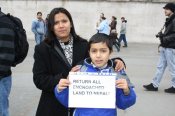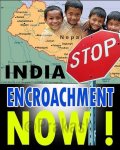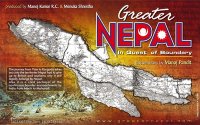The Anglo-Nepal War 1814–1816
Posted by Ram Kumar Shrestha on December 28, 2011
 As commander of the Gorkhali forces in Dheradun, Capt. Balbhadra Kunwar was handed the responsibility of defending the area. The expanding Nepali/Gorkhali State had since the mid-late 18th century expanded the nation’s border on all sides, which eventually led to conflict with the British East India Company and a war followed.
As commander of the Gorkhali forces in Dheradun, Capt. Balbhadra Kunwar was handed the responsibility of defending the area. The expanding Nepali/Gorkhali State had since the mid-late 18th century expanded the nation’s border on all sides, which eventually led to conflict with the British East India Company and a war followed.
 Realizing he could not defend the town of Dehradun, Capt. Balbhadra Kunwar withdrew to the strategic hill fort of Khalanga with an army strength of 600 including women and children against the British East India Company British stronghold of 3000-3500 troops. He turned down an incentive proposal of the British who would make him Governor of the WesternGarhwal should he surrender or leave Nepal.
Realizing he could not defend the town of Dehradun, Capt. Balbhadra Kunwar withdrew to the strategic hill fort of Khalanga with an army strength of 600 including women and children against the British East India Company British stronghold of 3000-3500 troops. He turned down an incentive proposal of the British who would make him Governor of the WesternGarhwal should he surrender or leave Nepal.
In the month of October 1814, Major General Sir Rollo Gillespie of the British army had advanced along with 3,500 troops and eleven pieces of cannon to occupy the Nepali territories situated between the Ganga and Yamuna rivers in the Gharwal and Kumaon regions that had been occupied by the Nepali forces. Captain Balabhadra Kunwar had maintained his position at a 400 cubits high hill in a place called Nalapani, situated north-east of Dehradun, to check his advance.
On Kartik 8, 1871, Bikram Samvat (October 1814), British troops reached Dheradun. A battle took place between British and Nepali troops at Nalapani on Kartik 10, 1871 B. Samvat. The British were unsuccessful and withdrew to Dehradun. Another battle was fought between the two sides at Nalapani on Kartik 17, 1871 Samvat (ca. Oct 31, 1814). General Gillespie, the British Commander, lost his life in that battle along with Col. Alice.
The siege continued for a month until the British, convinced that they could not win by military ways, blocked the source of water to the fort so that the Nepalese would die of thirst. For the Nepali Army it was a hard struggle fighting a very well equipped and trained modern army, belonging to one of the largest colonial Empires of the world. Balbhadra Kunwar had asked for reinforcements from the capital but Kathmandu could not send them any soldiers as the Nepali army had no reserve army and were an emerging power which means that they did not have troops to match the East India Company. The Nepalese army was out numbered in Nalapani as it was in every battlefield.
Even though the Nepali army lacked water they were still determined to defend their position. Because the walls had collapsed, cannonballs fired by the British started reaching the interior of the fort. Many men were killed or injured. Despite losing their comrades and friends the remaining men were still determined to defend their position. In order to drink water from the river they came out of the fort in a single line, and the British forces watched in surprise as the Nepali troops quenched their thirst and returned to their fort.
On Marga 16 (Nov 1814), four of the commanders, including Capt. Balabhadra Kunwar, in the night was forced to abandoned the fort of Nalapani with their remaining Gorkhali troops. On seeing the Nepalis abandon the fort, the British attacked them. The Nepalis resisted the attack but continued to advance. They reached Dwara in the morning of Marga 17, 1871 and stayed the whole day there.
Balabhadra sent a courier to the British with the following message: We had handed over to you your dead and injured soldiers on your request. We now request you to hand over our injured soldiers to us. The British replied that they would look after the injured (Nepali) soldiers themselves. Accordingly, they treated the 180 injured soldiers at the Nalapani fort.
The next day, Marga 18, 1871 Samvat, the Nepalis left Dwara for the Gopichand Hill, where they had decided to build a fort. Dwara was not considered suitable for that purpose.
The Nepalis spent the night at the Gopichand hill. At midnight, the British forces started shelling their camp. The Nepalis retaliated. Meanwhile, Sardar Ripumardan Thapa sustained an injury in his right arm from an enemy shell. He was unable to walk, and so was helped by his jamadar to climb the hill. However, he could not go on and was forced to stop. The other Nepalis continued to ascend the hill.
The next day, Marga 19, 1871 B. Samvat, men sent by Balabhadra carried Ripumardana to Chamuwa. Kaji Ranadipa Simha Basnyat also had arrived at that place. On Marga 20, Kaji Rewanta Kunwar reached there Subedar Dalajit Kanwar were killed by enemy fire.
Ultimately after 4 days of thirst, and a severe loss of troops, without surrendering, Capt. Balbhadra emerged out of the fort with drawn kukris in his hands (along with other 70 survivors) and roared to the British – “You could have never won the battle but now I myself voluntarily abandon this fort. There is nothing inside the fort other than dead corpses of the children and women”! He and his remaining troops escaped into the hills on November 30, 1814.
A peace treaty was signed on Dec 2, 1815 between the then King Girvan Yuddha Vikram Shah and the British East India Company, known as the Sugauli Treaty.
The British soldier-poet, John Ship, had written during the war about the Gorkhas:
“I never saw more steadinesses Or bravery exhibited in my life. Run they would not and of death They seemed to have no fear Though their comrades were falling Thick around them, as bold For we were so near to know That every shot of ours told.”
Invasion
General Gillespie‘s column was the first to enter the Gorkha territory. His army overran Dehra Dun and attacked Gorkha forces under Balbhadra Kunwar at Battle of Nalapani (also known as Kalanga). He made four detachments and ordered all-out attack at four Gorkha positions when a gunshot signal altered. However, only two detachments participated in the attack and his army was overwhelmed by Gorkha forces. A day before the Governor-General officially declared war on 1 November 1814, General Gillespie had been killed in the battle. In the interval before Gillespie’s successor Major-General Gabriel Martindale took over the command, Colonel Sebright Mawby managed to take Kalanga by cutting off its water supplies. Soon after, Martindale arrived and attacked Ranjur Singh Thapa’s garrison of 2,000 men at the battle of Jaithak. British bombardments eventually forced Gorkha army to retreat but they did not pursue them in fear of counter-attack in unfamiliar regions.
The British generals in the east were faced with mountainous regions, which were favorable for defense. Both Wood and Marley were reluctant to attack the enemy first. After two attempts to advance on Butwal, Wood, retreated and took up a defensive posture atGorakhpur. His compatriot, Major-General Harley, was also not able to achieve his objectives. After his advance posts at Samanpore and Persa were wiped out due to lack of support, he was reduced to inactivity and suddenly left his main camp.
The company’s hopes now rested on the abilities of Colonel Ochterlony’s force of around 950 Sepoys. Unlike the other generals, Ochterlony slowly pushed Amar Singh’s army to increasingly higher into the mountains until, in April 1815, the Gorkha general had been forced back into his main fort at Malaun.
The ensuing Battle of Dionthal was decisive. Attempts by Amar Singh’s most able lieutenant,Bhakti Thapa, to dislodge the British from the Dionthal ridge overlooking the Malaun fort failed. Although Bhakti Thapa was killed in the action on 16 April, the fort held out for a while. However, when news arrived announcing that Almora had fallen to Colonel Jasper Nicolls’ 2,000 strong force of regular sepoys on 26 April, Amar Singh Thapa’s response to British Forces that time is still famous that, he said, “I am a lion’s cub.” During the campaign Ochterlony was promoted to major general.
Second campaign
After Ochterlony’s successful campaign, the Kathmandu durbar failed to ratify the peace agreement signed on 28 November 1815. This reluctance to sign soon led to the second campaign. Lord Moira placed Ochterlony in command of the massive 17,000 strong invasion force, but again, most of them were Indian sepoys.
During the campaign in February 1816, Ochterlony decided to take a very infrequently used pass through the mountains. The failure there would have been a disaster for British. But the successful passage allowed Birith to directly emerge from the back and attack the Gorkha’s rear. He invaded Makwanpur which was taken after stiff fight at the cost of forty five soldiers and two officers.
While General Ochterlony advanced towards Makwanpur, simultaneous operations by the Chogyal (king) of Sikkim drove the Nepalese army from the east. Amar Singh Thapa took no part in the second campaign – he had retired to a temple, and died shortly after the war ended.
After the decisive battle of Makwanpur on 28 February 1816 and the fall of the neighbouring fort of Hariharpur (after Ranjur Singh abandoned his post), the situation became very critical for Nepal. The British threat to the capital Kathmandu compelled the Nepalese to ratify the treaty without any further delay.
Aftermath
The Treaty of Sugauli

The Treaty of Sugauli 4 March 1816. It suited Ochterlony to bring the campaign to a speedy conclusion because of the approach of the dreaded aul-fever season but also because a number of his European troops were suffering from dysentery.
The British never had the intention to destroy either the existence or the independence of a state which was usefully interposed between them and the dependencies of China. TheTreaty of Sugauli was ratified on 4 March 1816. As per the treaty, Nepal lost Sikkim (includingDarjeeling), the territories of Kumaon and Garhwal, and most of the lands of the Tarai; theBritish East India Company would pay 200,000 rupees annually to compensate for the loss of income from the Tarai region. However, the Tarai lands had proved difficult to govern and some of them were returned to Nepal later in 1816 and the annual payments abolished.
The Mechi River became the new eastern border and the Mahakali river the western boundary of Nepal. Kathmandu was also forced to accept a British Resident.





















Ram Kumar Shrestha said
Chanakya Sharma and Jb Rai like this.
Jb Rai The final battle in Deothal on the 16th of April 1815 fought by Bhakti Thapa (aka Chegu Dura!) must not be left out from the history of the Anglo-Nepal war!
about an hour ago · Unlike · 1
Jb Rai त्यो लिङ्कमा ‘Battle of Dionthal’ भनिएको रहेछ – खास गरेर त्यसको spelling गलत भएको हुनु पर्दछ – अन्तिम र निर्णायक युद्ध नै देउथल मा भएको थियो, जहाँ सबैभन्दा बुढो (७०/७१/७४ बर्षे!?) काजी भक्ति थापा (चेगु दुरा) शहिद भएको थियो – भगुवा बलबहडर (बलबहादुर हुनु पर्दछ!) जसलाई नेपाली इतिहासकारहरूले ‘बीर’ बलभद्र लेखेर ठूलो बनाए, त्यसरी नै दोधारे अमरसिंह थापा ले अक्टोरलोनीका छोरासँग आफ्नो छोराको मित पहिलै लगाएर घुस-पैठ गरिसकेका थिए।
57 minutes ago · Unlike · 1
Ram Kumar Shrestha Thanks a lot for your valuable comments JB sir. The thing is that I received some mails and posted without going thru the material due to the lack of time n will publish others in the coming days. I will keep yr suggestions in mind. I would like to inform you that even Wikipedia started to mention “Complete Nepal” although it is not long time since we changed “Greater Nepal” into “Complete Nepal” : The idea of “Complete (Greater) Nepal” motivates not only some Nepali nationalists but a majority of Nepalese academicians ……@http://en.wikipedia.org/wiki/Greater_Nepal#cite_note-Telegraph_Nepal-0
35 minutes ago · Like · 1
Jb Rai Ram Sir, I was the one pushing the ‘correct’ terminology everywhere, I had even tried to change the ‘heading’ Greater Nepal as Complete Nepal in wiki however not been able to do so. 🙂
23 minutes ago · Unlike · 1
Ram Kumar Shrestha Within Wiki also there could be hidden st. I spent more than 2 weeks to prepare doc of Lumbini Kapilvastu Day Movement (before Kapilvastu Day Movement) in Wiki, but after couple of months it was gone n even email address in the name of movement was disabled. Frequently getting lots of problems in FB accounts n emails. Let’s be optimistic everything will be fine in the future as future could be ours.
12 minutes ago · Like
Jb Rai राम सर, मैले नि माथी गल्ति लेखि हालेछु – ‘सरदार’ भक्ति थापा हुनु पर्नेमा ‘काजी’ लेखेछु (काजी त अमरसिंह थापा पो थिए) – लमजुङ्गे भक्ति थापा गोर्खाली सेनामा मिसिदा २ शर्तहरू थिए;
१) मलाई कहिल्यै पनि जमजुङ तिर गोली हान्न आदेश नदिइयोस् र
२) मलाई सरदार भन्दा माथीको पद कहिल्यै स्वीकार हुने छैन।
9 minutes ago · Unlike · 1
Ram Kumar Shrestha Thanks JB sir. I think better to leave these conversation as comments in the relevant posting so that if I will forget to correct, these conversation could be helpful.
a few seconds ago · Like
gaurab said
Can you guys say why were the nepalese army compelled to sign the treaty?
yangsum said
jb sir tapai sang kehi nepal ko etihaas janna man xa…
yangsum said
jb sir tapai sang kehi janna sakina ????
gunesh jha said
i m proud to see the history of nepal
prem gahire said
After reading the historty of battle of anglo nepal war. i feel very proud that we are generation of those brave soldiers.
cars said
Are you feeling like you do not have the car you deserve?
This is because the salesman is trying to get a great commission out of you.
Don’t treat a salesperson like a friend. Continue reading for some valuable tips and information.
ashish karki said
story really make proud that I am the son of such bravery person
ManChesteR UniTed said
Not too bad …but the British should hav returned the property of Nepal ( which was taken by the Sughauli Treaty ) after leaving the Dhotis ….
Sandesh Neupane said
I am proud of Nepal history but british should return Nepal terriority.
kayakalpa said
REALLY NICE TO GET CHANCE TO READ